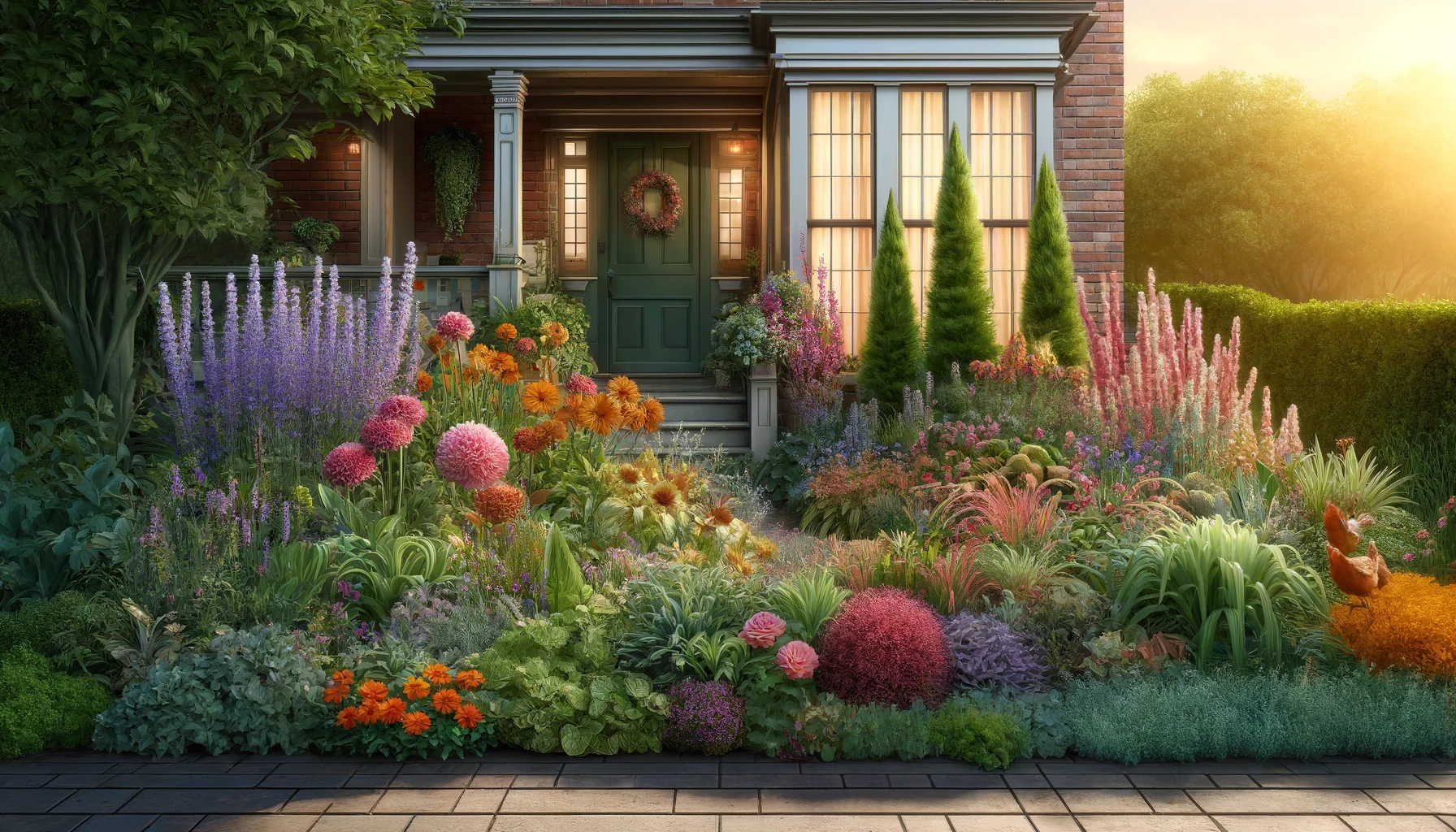Imagine your home as a book and your front yard as its cover.
What would it say? Would it whisper tales of color and life, inviting guests to discover the stories within?
The front flower bed is more than just a patch of soil; it’s the first hello and the last goodbye, a canvas where nature’s colors paint a warm welcome.
Let’s dig into nine enchanting front flower bed ideas that promise to transform your entrance into a vibrant greeting card, unfolding beauty with each season.
1. The Color-Coordinated Welcome Mat

Crafting a color-coordinated flower bed is like dressing up your home in its Sunday best, every day.
Choose a color palette that complements your home’s exterior and stick with it, creating a harmonious visual flow.
- Colors to Consider: Soft lavenders and bold purples for a serene welcome, or vibrant yellows and oranges for a burst of happiness.
- Plants: Lavender, Salvia, Marigolds, Sunflowers
Tip: Group plants in odd numbers for a more natural and appealing display. Think of it as setting the table for guests—the presentation is key!
2. The Evergreen Frame

Incorporating evergreens into your front flower bed ensures year-round greenery, framing your floral masterpiece regardless of the season. It’s like having steadfast friends who stand by you, rain or shine.
- Evergreens to Include: Boxwoods, Dwarf Alberta Spruce, Holly
- Pair With: Seasonal blooms to add color and texture
Personal Anecdote: My grandmother always said, “A garden without an evergreen is like a smile without teeth.” It’s the structure that holds everything together.
3. The Pollinator’s Paradise

Design a flower bed that doubles as a haven for bees, butterflies, and birds. Not only will you support local ecosystems, but you’ll also enjoy a garden abuzz with life and movement.
- Attract With: Coneflowers, Lavender, Butterfly Bush, Zinnias
- Bonus: Add a birdbath or a bee waterer to provide a refreshing pit stop for your winged visitors.
Playful Metaphor: Think of your flower bed as a bustling café for pollinators, where every bloom is a delicacy on the menu.
4. The Perennial Cornerstone

Perennials are the gifts that keep on giving, returning year after year to grace your garden with their beauty. A flower bed anchored by perennials is like a cherished tradition, growing richer with time.
- Must-Haves: Hostas, Peonies, Daylilies, Russian Sage
- Why Perennials? They offer a sustainable and evolving garden foundation.
5. The Edible Edging

Who says beauty and utility can’t coexist? Border your flower bed with edible plants like herbs and leafy greens. It’s a feast for the eyes and the table.
- Edible Options: Chives (with their lovely purple flowers), Kale, Swiss Chard
- Dual Purpose: Aromatic herbs like lavender and rosemary add fragrance as well as flavor.
Insight: Gardening is not just about beauty; it’s a love affair with life, embracing both its flavors and its flowers.
6. The Succulent Tapestry

Succulents offer a low-maintenance and drought-resistant option, weaving a tapestry of textures and forms. It’s like nature’s artwork, resilient and evergreen.
- Succulent Picks: Sedum, Sempervivum, Echeveria
- Arrangement: Create patterns and shapes for visual interest.
Tip: Succulents are the perfect choice for busy gardeners or those in drier climates, proving beauty doesn’t have to be high-maintenance.
7. The Cottage-Style Charm

Evoke the whimsy of a storybook cottage with a mix of wildflowers and traditional blooms. This approach is less about precision and more about letting nature take the lead.
- Flowers to Include: Foxgloves, Hollyhocks, Lavender, Daisies
- Style Tip: Aim for a “planted by nature” look, as if the flowers chose their own places to grow.
Personal Anecdote: I once let a corner of my garden “go wild,” and it became the most enchanting spot, attracting more butterflies and bees than I could have hoped for.
8. The Layered Look

Design your flower bed in layers, from tall background plants to mid-sized middlegrounds, down to low-growing foregrounds. It’s a living diorama, offering depth and interest from every angle.
- Background: Tall grasses or shrubs
- Middleground: Medium-height perennials
- Foreground: Groundcovers or low annuals
Design Secret: Layering creates a sense of abundance and variety, making even the smallest beds seem lush and full.
9. The Seasonal Showcase

Celebrate the passing of time by designing your bed to showcase different plants each season. It’s a garden that tells time, marking the seasons with changing colors and textures.
- Spring: Tulips and daffodils
- Summer: Daylilies and lavender
- Fall: Chrysanthemums and ornamental kale
- Winter: Evergreen accents and winter-blooming pansies
Tip: This approach requires a bit more planning but offers a dynamic and ever-changing garden experience.
Your front flower bed is the prologue to the story of your home. It sets the tone, welcomes friends, and charms passersby.
Whether you opt for the structured beauty of a color-coordinated bed, the wild allure of a cottage-style garden, or the sustainable bounty of an edible edge, remember that each plant, each flower, adds a word to the story.
So, what will your garden say? Let it speak of joy, of life, and of the endless dance with nature. After all, the best gardens are those planted with love, where every bloom is a verse in the poem of home.
